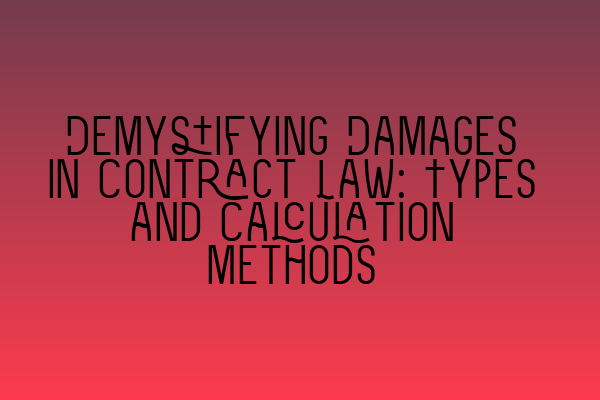Demystifying Damages in Contract Law: Types and Calculation Methods
Contracts are the foundation of business transactions and relationships. They provide a framework for parties to enter into agreements and define their rights and obligations. However, not all contracts proceed smoothly, and disputes can arise. When breaches occur, the party who suffered harm may be entitled to damages as a remedy.
In contract law, damages are a monetary award that aims to compensate the injured party for the loss suffered due to the breaching party’s failure to fulfill their contractual obligations. Understanding the different types of damages available and the calculation methods is crucial for both solicitors and individuals involved in contract disputes.
Types of Damages
1. Compensatory Damages: Compensatory damages aim to put the injured party back in the position they would have been in had the breach not occurred. These damages are designed to cover both actual losses and foreseeable consequential damages. Actual losses include direct costs incurred due to the non-performance, whereas consequential damages refer to indirect losses that result from the breach.
2. Expectation Damages: Expectation damages are a subset of compensatory damages and are based on the principle of expectation interest. They aim to place the injured party in the position they expected to be in had the contract been fully performed. These damages typically cover lost profits and benefits that the injured party would have gained from the contract.
To calculate expectation damages, the court will consider various factors such as the value of the performance promised, the market value of the performance, any costs avoided by the injured party, and any losses suffered by the breaching party due to the non-performance.
3. Consequential Damages: Consequential damages are indirect damages that arise as a result of the breach but are not necessarily a natural consequence of it. These damages are recoverable if they were foreseeable by both parties at the time of contract formation. Examples of consequential damages include lost profits, lost business opportunities, and reputational harm.
4. Reliance Damages: Reliance damages aim to compensate the injured party for the expenses and investments made in reliance on the breaching party’s promise. These damages are awarded when expectation damages are too speculative or uncertain. Reliance damages typically include costs such as preparation expenses, expenditures incurred in performance, and any losses suffered due to the non-performance.
Calculation Methods
1. Specific Performance: In some cases, the injured party may seek specific performance, which is a court order requiring the breaching party to fulfill their contractual obligations. This remedy is typically available for unique goods or services and is granted at the court’s discretion.
2. Restitution: Restitution is a calculation method used to determine the amount the injured party should be restored to their pre-contract position. It involves returning any benefits that the breaching party received due to the contract’s non-performance. Restitution is commonly used when other calculation methods are not feasible or adequate.
3. Quantum Meruit: Quantum meruit, which means “as much as deserved,” is a calculation method that determines fair compensation for services rendered or goods supplied based on their reasonable value. This method is often used when the contract is silent on the price or when the agreed price cannot be calculated due to the breach.
4. Liquidated Damages: Liquidated damages are contractually agreed-upon damages that parties stipulate in the contract itself in anticipation of a breach. These damages are predetermined and serve as a measure of compensation in case of non-performance. However, liquidated damages must be a genuine pre-estimate of loss and not excessively punitive to be enforceable.
It is essential to note that the calculation of damages in contract law can be complex and subjective. The court will consider various factors, including the nature of the contract, the type of breach, the parties’ intentions, and the availability of evidence.
Conclusion
Damages play a crucial role in compensating injured parties in contract disputes. By understanding the different types of damages available and the calculation methods, solicitors can effectively advocate for their clients and ensure they receive fair compensation for the harm suffered.
If you’re preparing for the SQE exams or looking for additional resources to enhance your legal knowledge, we offer SQE 1 Practice Exam Questions and SQE 1 Preparation Courses. For those preparing for SQE 2, we provide SQE 2 Preparation Courses. Stay updated with the latest SRA SQE Exam Dates to plan your study schedule effectively.
